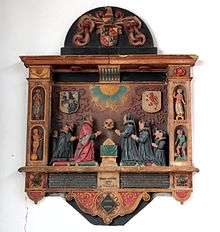The Layer Monument

Located in the Church of Saint John the Baptist, Maddermarket, Norwich, the Layer monument is an early 17th century marble, polychrome mural monument (320 × 350 cm) installed to the memory of the lawyer Christopher Layer (1531–1600).
Inscription
Translated from Latin its inscription reads-
This Urn of cold marble covers Christopher Layer who bore Christ in his heart along with Imperial Minds, Numa known for his justice, Fabius for his legal robe, and Cato for his strict morals. He had seen thrice twenty and thrice three years when he gave his body to be covered by the earth. He was great in years but greater with much honour, for twice he was Mayor of Norwich. His dearest wife bore him five daughters and three sons when she became a sad relic with a widow's bed. But two sons died and the one who survived his father placed here this tomb. Father died 19 June 1600 Mother died 23 January 1604.
Interpretation
The monument is notable on two accounts, firstly, its four figurines housed in its two columns, Pax and Gloria, Vanitas and Labor, are relatively rare examples of Northern Mannerist sculpture extant in Britain; secondly, these four figurines exemplify how, during the era of Elizabeth I, Christian iconography occasionally integrated symbolism which originated from the western esoteric traditions of alchemy and astrology into works of art, including funerary monuments.[1]
The Layer Quaternity

The four figurines of The Layer Quaternity share a number of iconographical details to an illustration found in Alchemia (1606) by the German academic Andreas Libavius in a chapter entitled De Lapide Philosophorum (The Philosophers' Stone) including - an identical pairing of a lower mortal pair with an immortal pair of bare-legged male and draped female above them, the shared titled captions of Gloria and Labor, along with both monument and illustration also depicting a palm branch, sun, moon and rotundum.
Symbolically, the Layer Quaternity correspond to the alchemical 'deities' of Apollo, Luna, Mercurius and Vulcan as named in Atalanta Fugiens (1617) by the German alchemist-physician Michael Maier (Emblem XVII).[2]
Collectively the Layer Quaternity are a unique alchemical mandala.[3] Through polarized symbolism they delineate essential coordinates associated with Mandala art, namely Space (Heaven and Earth) and Time (Young and Old). Utilizing variety and multiplicity, key attributes of Northern Mannerist art, they also represent fundamental aspects of the human condition, namely, gender, youth and age, pleasure and suffering. A fifth, uniting symbol, a skull, is located at the very centre of the monument. The skull is the commonest of all momento mori symbols in funerary art. It was also defined as the philosophical vessel (Vas Philosophorum) in Renaissance-era alchemy.
The role of the Quaternity in religious symbolism is discussed in depth in the writings of the Swiss psychologist Carl Gustav Jung. In essence, the Layer monument's four figurines represent spiritual entities which agree with Jung's analytical psychology, that the psyche moves toward individuation in fours (made up of pairs of opposites).[4][5][6][7]
See also
References
- ↑ Frances Yates The Occult Philosophy in Elizabethan England pub. RKP 1973
- ↑ J.B. Craven Count Michael Maier Life and Writings 1910 reprint 2003 Ibis Press
- ↑ Adam McLean The Alchemical Mandala pub. Phanes 1989
- ↑ C.G. Jung 'The Quaternio and the mediating role of Mercurius' CW Vol. 14 para. 5–13 pub. RKP 1955
- ↑ Carl Jung 'The Quaternity of the Homo Maximus' C.W Vol. 13 para. 206–209 pub. RKP 1968
- ↑ C.G.Jung 'The Philosophical Tree' (1954) 3.The Tetrasomia CW.13 para. 358–68 RKP 1968
- ↑ The Layer monument: An Introduction and interpretation as an Alchemical Mandala. Kevin Faulkner pub. Pride Press 2013